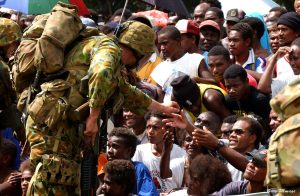As the 20th anniversary of the commencement of the Regional Assistance Mission to Solomon Islands (RAMSI) passes by this month, there will be several narratives about RAMSI promoted in Solomon Islands and globally. One of these is the narrative of RAMSI, which was led by Australia, as a “success story.”
Where does this narrative come from, and is it just a story or a reflection of reality?
From 1998 to 2003, Solomon Islands had a civil conflict with widespread consequences for the archipelago of many islands, including 200 documented fatalities. Ten percent of these deaths were a result of fighting between militants from Guadalcanal and Malaita, as documented in the Solomon Islands Truth and Reconciliation Report.
After arriving in July 2003, by November of the same year RAMSI had removed 3,700 weapons, arrested 773 people, and laid over 1,000 charges against militants. Another 1,755 weapons were collected in 2002-2003 by the International Peace Monitoring Team, churches, and the National Peace Council.
The role of RAMSI in this short, sharp success in disarmament and cutting down violent crime was noticed and appreciated. In 2003-2004 a number of people named their babies “Ramsey” or other names related to the intervention. Women peacemakers that had lobbied their government to allow RAMSI into the country were thankful for the disarmament, although these women’s groups were subsequently sidelined.
Then RAMSI shifted focus to governance, but not in the ways expected. Civil society’s desire for change, to build peace between people, create a decentralized government responsive to people’s priorities, and address the grievances of former militants, as listed in the Townsville Peace Agreement, was not on RAMSI’s agenda. RAMSI was not an international intervention to reshape governance in light of what caused the conflict in the first place, as would be expected in U.N.-led conflict interventions.
Given that the intervention only occurred because of the invitation of the same government that had let the country unravel, RAMSI instead became “an intensive state capacity building program.” Advisers were installed in key government institutions, and the intent of RAMSI was to work within the Solomon Islands government for reform and “good governance.”
While expectations of RAMSI were high, following the success of disarmament, its goals were somewhat regressive: to “restore law and order” and the “state,” rather than to imagine systems that would foster peace. The assumption of this narrative was, of course, that the state in its previous iteration worked well and provided security. Other forms of governance, such as Indigenous systems based around chiefs and local leaders, or provincial level governance, were overlooked.
With the rationale of RAMSI being built from the narrative of Solomon Islands as a “failed state” that would open up an “arc of instability,” it was destined to be a “state-building” mission. With this shift in focus and approach after the initial disarmament, so began the disputes over what “success” for RAMSI would look like in post-conflict Solomon Islands.

































